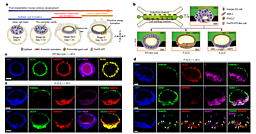Development of Embryonic-Like Tissue from Stem Cells
TECHNOLOGY NUMBER: 2020-094

OVERVIEW
Novel ex vivo system to study human embryo implantation and early development- Allows for a multitude of conditions that foster an ideal system for drug screening
- Structures are more characteristic to human embryology compared to existing 2D systems
BACKGROUND
One of the first steps of human development is the implantation of embryonic tissue into the placenta. Implantation occurs via a process called amniogenesis, whereby an amniotic cavity is formed from an epiblast, the pluripotent cell lineage which forms the definitive germ layers which guide development. As such, amniogenesis is the first of several steps following which a cascade of events leads to the formation of a viable fetus. The amniogenesis process remains relatively poorly understood due to the difficulty in studying human embryos. As such, a need exists to further research human pluripotent stem cells (hPSCs) to better understand the role of amniogenesis in fertility issues.
INNOVATION
Researchers at the University of Michigan have invented an engineered three-dimensional space made from a biological hydrogel which mimics the human peri-implantation environment. Following seeding with human pluripotent stem cells, the model fosters self-organization of these hPSCs into amniotic, tissue-like structures. These cells express many of the characteristic markers associated with early human embryonic development. This novel tool may be used both for the study of development and implantation as well as for screening of new drugs which may aid the treatment of infertility.
PATENT APPLICATION
Number: WO2018106997A1
-
expand_more mode_edit Inventor (2)Jianping FuYi Zheng
-
expand_more library_books References (1)
- Zheng Y, et al. , Controlled modelling of human epiblast and amnion development using stem cells. Nature volume 573, pages 421–425 (2019).
-
expand_more cloud_download Supporting documents (1)Product brochureDevelopment of Embryonic-Like Tissue from Stem Cells.pdf